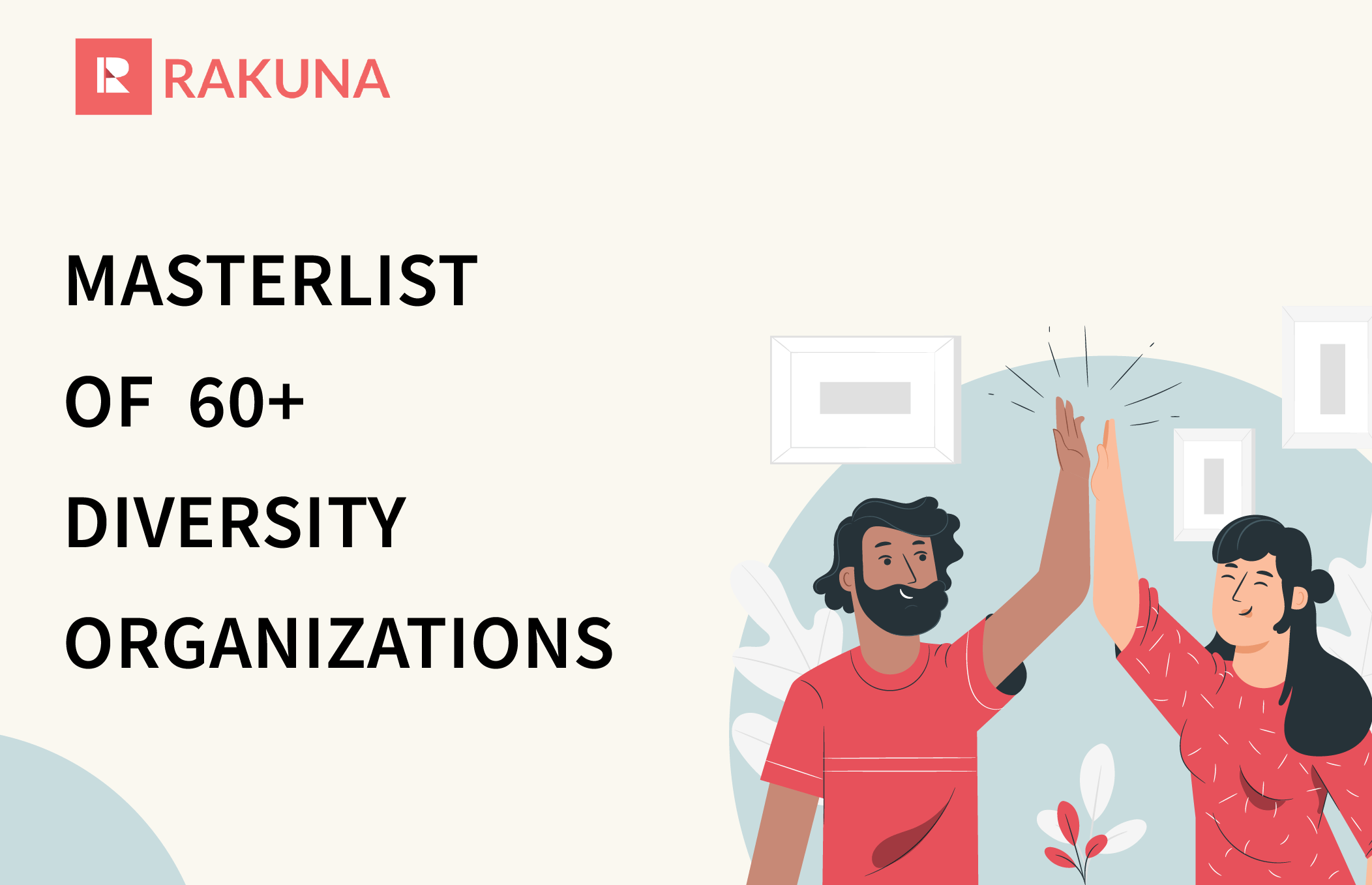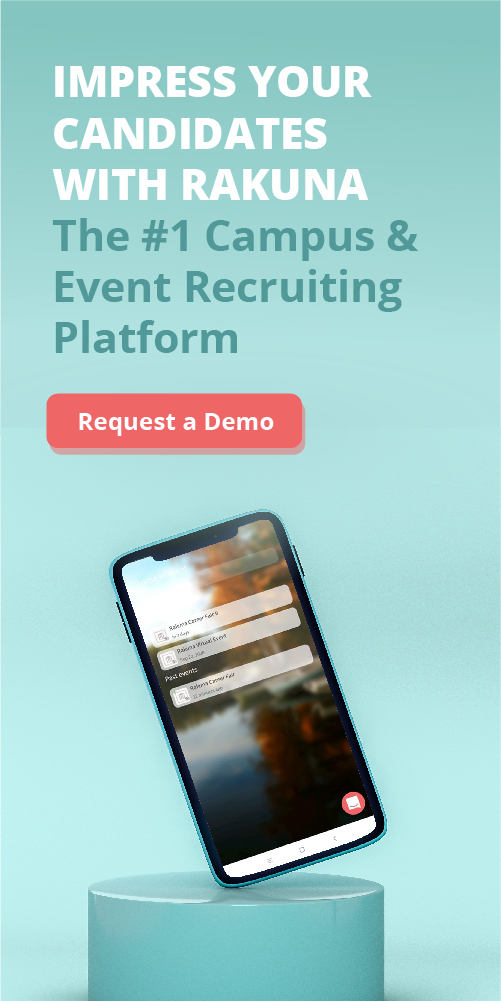Generating diversity awareness and finding diverse talent is one of the top challenges for campus recruiters today. How can your organization better connect with, market to, and recruit minority students and graduates? The answer is complicated but begins with developing a targeted and well-planned internal and external recruitment strategy for your organization.
Whether launching or rebooting your diversity recruiting programs, consider implementing these 16 tactics to create a successful diversity recruiting program at your organization.
What is Inclusion and Diversity Recruitment?
Diversity recruitment aims to foster an inclusive hiring process, ensuring that all highly qualified candidates are welcome, with particular attention given to providing opportunities for underrepresented groups. Diversity encompasses various facets, including race, gender identity, abilities, veteran status, age, neurodiversity, and more.
It’s crucial to emphasize that the term “diverse” extends beyond mere references to “women” or “people of color.” Diversity is a concept that encompasses a wide spectrum of identities. Additionally, it’s important to refrain from labelling individual people as “diverse.”
Diversity recruitment doesn’t revolve around achieving quotas or hiring based solely on protected characteristics, which is both illegal and counterproductive. Instead, the focus should be on selecting candidates based on their distinct perspectives, life experiences, and skill sets. This approach not only ensures compliance with the law but also enriches the talent pool available for your job openings.
Why Workforce Diversity Is So Important
With recent global inequality-related issues, diversity and inclusion once again take the front-and-center position of employment factors. It has been proven time and time again that having a diverse workforce can bring a lot of tangible benefits to a business; some of them include:
- Faster problem-solving and more innovative ideas, thanks to varied perspectives
- Avoid the “Us and Them” mentality when having a conflict of interest
- Raise employee confidence
- Boost team engagement
- Easier recruitment thanks to referrals from your employees
A diverse workforce allows your employees to have more healthy discussions and less aggressive confrontations whenever problems arise. Diversity in the workplace has always been a much-researched topic, and the benefits always have data to back them.
According to McKinsey & Company, companies that display high gender equality in their executive team have a 25% chance of having higher profitability than those that do not.

Source: McKinsey & Company – Diversity wins: How inclusion matters – May 19, 2020 reports
Rather hear it from an expert? Check out TED Speaker – Rocío Lorenzo on why diversity makes your team more innovative!
Now that we have gone through the benefits, it’s not a question of whether your recruiting team should have a diversity strategy. It’s a question of how you can do it. Let’s go through some of the diversity recruiting tactics to enhance your upcoming project!
Enhance Diversity Recruiting Strategy in Sourcing
In the pre-pandemic landscape, black women were paid 63% less than a white worker’s median annual earnings—$24,110 less even with a full-time, year-round position.
Attend Virtual Career Fairs for Targeted Minority Student Groups
Virtual career fairs are a cost-effective and efficient way for companies to tap into a broader talent pool. These online job expos are particularly effective in connecting with minority groups such as veterans, women, and people with disabilities.
Host Your Virtual Fair:
If your organization has the resources, consider hosting your virtual job fair. A great example is Verizon, which successfully hosted veteran recruiting virtual job expos. KPMG also attracted over 10,000 candidates worldwide to their virtual job expos.
Explore Diversity-Focused Options:
If hosting your own event seems like a big step, you can explore diverse-focused virtual job fairs. Here are some excellent options:
- CareerEco is a virtual recruiting platform for job seekers, prospective graduate students, academic institutions, and employers.
- Their Bender Virtual Career Fair connects employers and job seekers with disabilities online, with over 1,000 registrants from all over the U.S. in the past.
- Getting Hired is dedicated to creating employment opportunities for job seekers with disabilities.
- They also host traditional virtual job fairs connecting employers with job seekers.
- Veteran Recruiting is a global leader in virtual recruitment events for the military community.
- Their past events have helped more than 120,000 veterans find meaningful employment, with participation from major corporations such as Accenture, Apple, and more.
- Diversity in Ed is a multinational publication and teacher recruitment resource center.
- They’ve partnered with Vfairs to host virtual job expos promoting diversity and inclusion for both candidates and employers.
By participating in or hosting virtual career fairs tailored to diverse student groups, your organization can access a rich talent pool and contribute to building a more inclusive workforce.
Recruit Where Diversity Thrives

Recruiting and sourcing are similar to a sales process. To effectively find diverse talent for your recruitment pipeline, recruit where diversity thrives.
Incorporating diversity and inclusion elements into your recruitment processes is vital. Many universities have student groups that represent minority or underprivileged communities. When strategizing your campus recruitment, include schools with diverse student bodies that represent underrepresented students.
According to NACE, the most common sources for diverse recruiting among employers are Historically Black Colleges and Universities (HBCUs) and Hispanic Serving Institutions (HSIs). Building strategic partnerships with schools that primarily serve minority populations can significantly boost your diversity recruiting ROI.
Consider these top colleges and universities from U.S News’ Campus Ethnic Diversity Index when recruiting underrepresented students:
- Andrews University – Berrien Springs, MI
- University of San Francisco – San Francisco, CA
- Johns Hopkins University – Baltimore, MD
- Stanford University – Stanford, CA
- University of Hawaii at Hilo – Hilo, HI
- University of Maryland, Baltimore County – Baltimore, MD
- George Mason University – Fairfax, VA
- New Jersey Institute of Technology – Newark, NJ
- New York University – New York, NY
- Rutgers University–Newark – Newark, NJ
- University of California, Los Angeles – Los Angeles, CA
If you’re based in the United Kingdom, explore top-ranking universities based on the Hotcourses Diversity Index:
- Kingston University
- University of London
- Middlesex University
- UCL (University College London)
- Open University
These universities can be excellent sources of diverse talent for your recruitment efforts.
Collaborate with Multicultural Associations and Student Groups

National and regional professional associations and student groups centered around various minority communities provide excellent opportunities to boost your brand and diversify your talent pool. You can achieve this by strategically sponsoring, offering thought leadership, and hosting events within these communities. This approach ensures a steady influx of diverse candidates.
Successful companies have already blazed this trail:
- SAP, a global organization, headquartered in North America, but with a presence in over 150 countries, stands out with a remarkable 27% of women in leadership positions globally. Their ‘Project Propel’ initiative partners with Historically Black Colleges and Universities (HBCUs) to teach software skills to undergraduate and MBA students, with the goal of nurturing a pipeline of potential hires from these institutions.
- Marriott is an active member of organizations supporting diverse suppliers, such as the National Gay and Lesbian Chamber of Commerce, the Women’s Business Enterprise National Council, and WEConnect International.
- Toyota collaborates with the U.S. Chamber of Commerce Foundation’s ‘Hiring Our Heroes’ initiative, focusing on hiring military veterans.
If you’re considering initiating or enhancing partnerships with minority student and professional organizations, you can refer to this comprehensive list of Inclusion and Diversity Professional & Student Organizations:

Establish Your Inclusion and Diversity Brand
A diverse team and a strong brand are closely connected, much like how diversity hiring expands your talent pool. In today’s job market, candidates have choices, and if they don’t feel welcome, they’re unlikely to choose your organization.
Having a reputation for inclusion and diversity in your employer’s brand can attract a wide range of customers, candidates, and potential partners. Here’s a simple checklist to help you establish and highlight your employer brand’s diversity:
1. On Your Company’s Career Page:
- Inclusion and Diversity Statement: Clearly state your commitment to diversity.
- Inclusion and Diversity Charter: Share your guiding principles.
- Inclusion and Diversity Images: Use visuals that represent diversity.
- Demographics Stats: Display relevant statistics.
- Employee Testimonials: Include videos or written interviews with employees from various backgrounds.
- Awards & Recognition: If you’ve received awards for your D&I efforts, don’t forget to mention them.
2. On Your Company’s Social Media:
- ERG Events: Share pictures from your Employee Resource Groups’ events and activities.
- Showcase D&I Efforts: Post images that reflect your organization’s D&I initiatives.
- Awards & Recognition: Keep your audience informed about any awards or public recognition for your D&I work.
3. On Your Company’s Print Materials:
- Inclusion and Diversity Vision & Statement: Replicate your diversity commitment in print.
- Inclusion and Diversity Images: Include visuals that celebrate diversity.
- Demographics Stats: Share relevant statistics.
- ERG Information: Provide details about your Employee Resource Groups.
- Awards & Recognition: Mention any awards or public recognition for your D&I initiatives.
4. During the Recruitment Process:
- Job Descriptions: Craft inclusive and clear job descriptions that appeal to a diverse pool of candidates.
- Diverse Interview Panels: Ensure that your interview panels reflect diversity and inclusion.
- Unbiased Evaluation: Train your hiring team to conduct unbiased evaluations of candidates.
- Accessible Application Process: Make sure the application process is user-friendly and accessible for all candidates.
- Feedback Mechanism: Implement a feedback mechanism for candidates, ensuring they receive constructive feedback after the recruitment process.
5. Job Descriptions:
- Clear Job Descriptions: Ensure your job descriptions are clear, inclusive, and free from jargon.
- Equal Opportunity Language: Use inclusive language that welcomes candidates from all backgrounds.
- Salary Ranges: Be transparent about salary ranges where possible.
- Accessible Application Process: Make your application process user-friendly and accessible to everyone.
Check out Rakuna’s Detailed Guide on Crafting Job Descriptions to Win Over Gen Z Candidates – the generation championing Inclusion and Diversity in the recruitment landscape.
6. On Your Company’s Social Media:
- ERG Events: Share pictures from your Employee Resource Groups’ events and activities.
- Showcase D&I Efforts: Post images that reflect your organization’s D&I initiatives.
- Awards & Recognition: Keep your audience informed about any awards or public recognition for your D&I work.
- Employee Spotlights: Feature regular employee spotlights on your social media, showcasing diverse voices and roles within the company.
- Company Culture Highlights: Share glimpses of your company’s culture through posts that highlight team activities and events.
7. On Your Company’s Print Materials:
- Diversity Vision & Statement: Replicate your diversity commitment in print.
- Inclusion and Diversity Images: Include visuals that celebrate diversity.
- Demographics Stats: Share relevant statistics.
- ERG Information: Provide details about your Employee Resource Groups.
- Awards & Recognition: Mention any awards or public recognition for your D&I initiatives.
- Company Brochures: Ensure that your company brochures reflect your company’s culture, values, and diversity initiatives.
- Recruitment Events: Provide information about any upcoming recruitment events or job fairs you’ll be attending.
Enhance Your Employee Referral Program

One of the best recruiting sources is word of mouth. Diverse employees know and talk to various individuals. Your employees share what it is like to work for your company. Because of this, your candidates’ perception of your company spreads throughout their communities.
To capitalize on your employees’ network, bolster employee-referral recruiting programs at your organization, including a deliberate message about the business need for a diverse workforce and the importance your company places on diversity referrals. Communicate your organization’s goals and where you are in the process of building a more diverse and inclusive workforce with your employees.
Another approach is to involve Members from your Employee Resource Group. Many firms use their ERGs for interviewing and hiring various candidates directly. For example, Ernst & Young used their LGBT ERG to help relocate a gay partner and his spouse to Cleveland from Paris by introducing them to the local LGBT community members.
Use Social Media to Source and Market to Diverse Talents

In today’s fast-paced world, social media is a powerful tool for building your employer brand and connecting with potential candidates. It offers a convenient way to identify and engage with diverse talents, making your recruitment efforts more inclusive.
1. Leverage LinkedIn’s Professional Communities
LinkedIn is a treasure trove of professional networks. There are numerous groups on the platform for almost every industry and interest. Your recruiting team can become active members of these groups, nurturing long-term relationships with potential candidates and sharing relevant job openings or company updates.
For instance, Kaiser Permanente has its recruiters join diverse LinkedIn groups, like female professionals, Latinos, and African Americans. LinkedIn also provides specific tips for diversity sourcing.
2. Utilize Facebook Groups and Ads
Facebook is another valuable channel for reaching diverse candidates. It allows you to tailor your messaging to specific demographics, making it a great choice for targeted advertising campaigns. You can create ads to reach various student groups, ensuring your message reaches the right people.
Another strategy is to establish a “Diversity Careers” Facebook Page and promote it through targeted advertising. This approach can help you raise awareness and engage with potential candidates interested in diverse career opportunities. Reach out to these groups and let them know their skills and talents are wanted.
Support Inclusion and Diversity through Philanthropy
Another possible approach to inclusion and diversity recruitment businesses can take is through the support of philanthropic activities. A business can establish or be part of educational and community partnerships to enhance its diversity-focused image and access a more diverse pool of talent.
For instance, Intel Corporation’s global investment organization, Intel Capital, introduced the Intel Capital Diversity Fund. This fund invests in technology startups led by women and individuals from underrepresented minorities.
Monsanto collaborated with its philanthropic arm, the Monsanto Fund, to encourage Black, Latino, and women students to pursue STEM (Science, Technology, Engineering, and Mathematics) subjects. These initiatives proactively increased diversity within their talent pool and strengthened their brand in diverse communities.
Organize Specific, Short-term Events for Underrepresented Student Groups
Numerous companies have created structured internship programs tailored to a diverse group of high-achieving college students who meet their organization’s requirements.
For example, PwC enhances its diverse campus hires through two programs: Explore and Start. Explore is a one-day early identification program for college freshmen and sophomores. Simultaneously, Start offers internship opportunities for college students in their sophomore and junior years.
EY operates the LAUNCH program, which targets ethnically diverse freshmen, sophomores, and transfer students. Accenture also runs its Accenture Student Leadership Program, designed for female and minority students in their freshman and sophomore years.
Use the Right Metrics to Monitor Your Diversity Recruiting Efforts

In the world of recruitment, what you measure, you can improve. It’s crucial to establish clear, measurable diversity recruiting metrics to track your progress. Here are some essential metrics for your team:
- Percentage of Diverse Candidates: Keep track of diverse candidates at every stage of your recruitment process.
- Minority Representation: Monitor the percentage of minorities at various levels within your organization.
- Employee Satisfaction (D&I): Gauge employee satisfaction with regard to Inclusion and Diversity and Inclusion (D&I) efforts.
- Retention Rate for Minorities: Track the retention rate among minority employee groups.
- Recognition and Awards: Pay attention to awards and recognitions from inclusion and diversity interests and advocacy groups for your D&I initiatives.
To measure individual recruiter effectiveness, consider these metrics recommended by Dr. John Sullivan, a renowned HR thought leader:
- Percentage of Diverse Candidates in Resumes: Calculate the percentage of diverse candidates in the resumes presented to hiring managers.
- Percentage of Diverse Candidates Interviewed: Track the percentage of diverse candidates interviewed by hiring managers.
- Percentage of Job Offers to Diverse Candidates: Keep an eye on the percentage of job offers extended to diverse candidates.
- Turnover Rate of Diverse Hires: Monitor the turnover rate of diverse hires within a year.
- Applicants’ and Managers’ Satisfaction: Assess the satisfaction rates through surveys, both from diverse applicants and managers after a diversity hire.
- On-the-Job Performance: Evaluate the on-the-job performance of diversity hires after one year.
As big data continues to transform the way we operate and analyze data, campus recruiting teams should strive to become more data-informed. By embracing the right campus recruiting software, recruiters can efficiently monitor these essential metrics and make more unbiased hiring decisions.
Effective use of campus recruiting software allows leaders to eliminate guesswork, develop evidence-based strategies, and showcase their team’s contributions to the organization. With a robust database of prospects collected from campus events, you can impress potential candidates with a streamlined interview process. Interview scheduling software is readily available to simplify and expedite every step of the process.
Develop Inclusive Company Policies for Diverse Candidates
Truly valuing inclusion and diversity means embodying those values in your everyday operations. This involves proactively implementing company policies that resonate with a diverse pool of candidates.
- Inclusive Time-Off and Scheduling: Revise your time off and scheduling policies to incorporate a wider range of religious holidays, community events, and similar occasions. Promote flexible work hours, allowing candidates to stay engaged with their communities without adhering to rigid schedules.
- Fostering Open Communication: Encourage your management teams to create an environment where employees feel comfortable expressing concerns about policies that may limit diversity. Acknowledging that individual biases can influence workplace dynamics, fostering transparent communication is vital to ensuring everyone feels included and valued.
By integrating these policies and actively highlighting them in your recruitment efforts, you can ensure that your diversity recruiting strategy is not just a statement but a living, breathing commitment.
Enhance Diversity in Candidate Screening
Reevaluate Your Candidate Screening Criteria
It’s essential to rethink the attributes you seek in potential hires and how you communicate with them. A crucial aspect of diversity-focused recruiting is continually questioning the qualities you prioritize in candidates, understanding why you do so, and whether any personal biases influence these choices.
Take a moment to review how you assess and select candidates, and honestly reflect on whether your methods inadvertently favor specific groups. If you discover such bias, consider adjusting your evaluation processes. If you’re uncertain, seek input from colleagues to gather diverse perspectives.
Blind-Hiring Techniques
Campus Recruiters are adopting a method to reduce bias in candidate selection by anonymizing resumes. This means removing personal details such as names, educational institutions, birthdates, and specific locations. Even unintentionally, these details can influence how we evaluate candidates.
Blind interviews follow the same principle as blind resumes, extending the bias-reduction strategy to initial candidate conversations. You can achieve this by sending text-based questions to candidates through your preferred recruitment platform. Candidates answer these questions anonymously and avoid sharing personal information.
The goal is to ensure an unbiased selection of candidates for further interviews. It’s challenging to eliminate all bias during phone or in-person interviews, making blind interviews most effective in the early stages of the hiring process.
Address Recruiters’ Burnout
A gateway for unconscious bias to set in is a burned-out team of recruiters. Burnout is possible in any occupation. However, campus recruiters are even more susceptible to this phenomenon.
In the SHRM post titled “Many Recruiters Are on a Path to Burnout,” J.D. Wildflower – founder of Holistic Success Institute in Minneapolis, was quoted saying:
“Recruiters’ role of serving others at the expense of expressing themselves and the constant interactions with many other people are additional factors that can lead to emotional fatigue and burnout.”
J.D. Wildflower – Founder of Holistic Success Institute
Working in a highly competitive environment with repetitive work processes can take a toll on individuals, making them more susceptible to unconscious bias. So here are a few ways to support your recruiters:
- Implement Comprehensive Well-being Programs: Companies should invest in comprehensive well-being initiatives tailored to the unique needs of their recruitment teams. These programs could encompass stress management, mental health support, work-life balance, and strategies for building emotional resilience. By caring for their recruiters’ well-being, organizations can mitigate burnout and its associated biases.
- Promote Diverse Training and Education: Fostering awareness about unconscious bias through regular training and education is vital. Recruiters should be equipped with the knowledge and tools to identify and combat bias in their hiring processes. By promoting inclusion and diversity at the core of their practices, organizations can mitigate the impact of unconscious bias.
- Streamline Recruitment Processes: Simplifying and automating repetitive tasks and processes in recruitment can significantly reduce the burden on recruiters. Recruitment Software like Rakuna’s Campus & Event Recruiting Solution and Interview Scheduling Software allows them to focus on meaningful interactions and decision-making, reducing stress and minimizing the risk of unconscious bias.
- Encourage Collaborative Decision-Making: Establishing a collaborative decision-making framework involving multiple stakeholders in the hiring process can help temper individual biases. By diversifying the perspectives involved in recruitment, organizations can enhance objectivity and fairness.
Enhance Diversity in Shortlisting and Hiring
ATS for Automated Shortlisting
Automating your shortlisting process with an Applicant Tracking System (ATS) can help you impartially filter out the most promising candidates. You can make use of the screening tools embedded within your chosen ATS to identify candidates with the strongest skill sets.
By adopting this approach, you eliminate the influence of personal opinions about specific candidates and concentrate solely on the information relevant to the job requirements. The act of shortlisting candidates based on specific criteria is a significant step toward enhancing inclusion and diversity in your hiring process.
If your initial talent pool boasts inclusion and diversity, your shortlist should naturally encompass candidates from a variety of backgrounds. If this isn’t the case, you can employ an effective diversity recruitment technique.
Diversifying Talent Pipelines
Three research published in Harvard Business Review introduced readers to a startling discovery: If only a single individual of a minority group (i.e., a woman or a person of an ethnic minority) in the shortlist, their chance of getting hired is close to 0.
The hypothesis for this finding is that being a single person with a unique trait will highlight the differences of that individual. For decision-makers, choosing “the different” can be considered risky as human nature does not encourage deviation from the norm.
To address this bias, you can implement the “two in the pool effect,” a diversity recruitment strategy.
The concept behind this strategy is to intentionally include multiple qualified candidates from the same minority demographic in your shortlist. This approach levels the playing field, ensuring that the best person for the job is selected, regardless of their background.
Promote your ERGs Early
Don’t wait until the onboarding stage. A straightforward way for your talent acquisition team and hiring managers to promote inclusivity is by sharing information about your company’s Employee Resource Groups (ERGs) during the interview process. During interviews, encourage them to discuss the ERGs your company offers, and the number of employees involved, and share examples of past or upcoming ERG events.
It’s crucial for today’s job seekers to see that your company supports inclusivity. According to a Gartner report on Candidate Experience and Inclusion and Diversity, 70% of Latinx, Black, BIPOC, and Asian candidates admitted to ending their application process prematurely due to concerns about diversity and inclusion practices and management style.
Promoting ERGs during the interview process helps candidates feel an immediate sense of belonging and the opportunity to join a community right from the start.
To Conclude
It is never too late to develop and optimize your Inclusion and Inclusion and Diversity Recruitment Strategy. In this guide, The Rakuna team has provided you with some of the most crucial best practices and approaches to build and improve your recruitment strategy to champion Diversity and Inclusion.
Already applying these 16 D&I Recruitment Approaches? See how Rakuna’s Total Recruiting Software Solution can streamline your recruitment processes. Book Your Free Demo Today
Images in this blog are designed by Freepik

